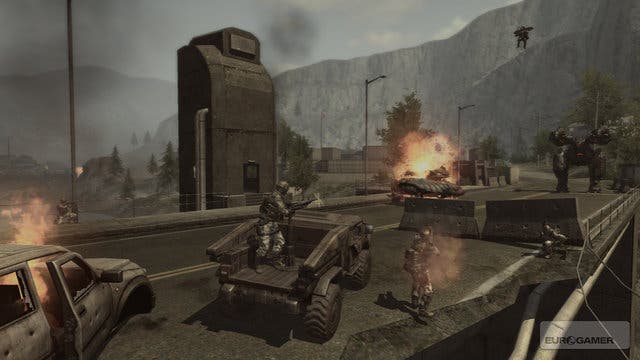Enemy Territory: Quake Wars
Lust in translation?
Has a console conversion of a PC game ever ended up better than the source material? With so many compromises made in the graphics department, and various control, interface and gameplay tweaks for developers to take into account, you're onto a loser from the start, and sofa-bound gamers are often left with little more than an approximation of the original vision. Sadly that's more or less what we're dealing with here. Knowing full well the limitations it faced on the technical side, Nerve Software - developer of our Xbox 360 review copy - at least invested a fair amount of effort to make Enemy Territory: Quake Wars more approachable. The main failing is that Quake Wars simply doesn't have enough spark in the gameplay department to compete with the riches that have befallen the shooter genre in recent times.
The game's premise is a familiar one: it's a team-based, eight-on-eight, objective-orientated first-person shooter. Set over 12 medium-sized maps, you can choose to play either as the human GDI forces, or plump for those bio-mechanical, chain-smoking Barry White fans, the Strogg. Set against the clock (usually 20 minutes), one team is on the offensive, while the other seeks to thwart the three or four of their opponents' objectives. This usually involves trying to blow something up, hacking a piece of equipment, and maybe taking a data disk somewhere else to upload it to a lucky fellow elsewhere in the Quake universe. You win if you can achieve your objectives within the time limit, or, conversely, prevent your opponents doing their ugly deeds.
To add to the fun, each side has five classes of unit, and you can choose to respawn at any time as a soldier, medic, covert ops, engineer or field ops (the specific units on each side are given slightly different names, but essentially they fulfill the same roles). A slick interface makes it a simple process to see which unit can complete the current objective - by hitting 'back' on the pad, you can cycle through the five unit types, and a green tick indicates whether that particular unit is capable of doing the job, as well as letting you know how many of that specific unit are currently on the battlefield. With a couple of button presses, you're able to parachute back into the action at the spawn-point of your choice and get going.

In one of the more useful tweaks to the console versions, tasks such as bomb-planting, hacking and repairing are now context-sensitive actions, meaning that you can simply walk up to the item and press X rather than having to cycle through your inventory to find a specific tool as you had to on the PC. Elsewhere, the sub-missions that featured in the PC original (such as repairing emplacements and vehicles) have been dropped, allowing you to focus on the main objectives. These minor tweaks go a long way to making the game a lot slicker in the heat of battle, and, yes, more fun. The previous learning curve confusion has been further aided by the inclusion of a tutorial, too - although for some curious reason it only features on the 360 version.
Undoubtedly the most jarring aspect of Quake Wars is that the run-and-gun side of the combat never manages to feel like Quake in any way. Simple machinegun fire (or even pistol fire) is often enough to see off your opponents, even from a distance, and the process of transferring the combat to a battlefield has pushed it in a direction far removed from the brand's rocket-duelling origins.


